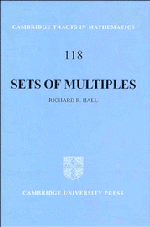Introduction
Published online by Cambridge University Press: 19 January 2010
Summary
The study of sets of multiples began in the thirties as an abstraction from one special problem. A number of mathematicians, including Behrend, Chowla, Davenport, Erdös and Schur, had been interested in abundant numbers, (the positive integers not greater than the sum of their proper ivisors), in particular whether the proportion of such integers ≤ n converged to a limit with increasing n. This was proved by Davenport (1933), using an analytic method involving the Stieltjes moment problem due to Schoenberg (1928), which Schoenberg had applied to a similar problem about the Euler ø-function. A few months later Erdös (1934) gave an elementary proof of this theorem; general ideas which developed into the subject now called sets of multiples can be discerned clearly in both these proofs. We shall not be concerned with abundant numbers in this book, nevertheless it may be helpful to use this historical example as an illustration. We note the property that any multiple of an abundant number is abundant. This leads to the idea of a primitive abundant number, which is minimal in the sense that its proper divisors are not abundant. The abundant numbers then comprise all the multiples of these primitives. This immediately raises general questions about the sequence, or set, of integers which are multiples of the elements of a given base sequence, for example (as above) whether the former, top, sequence possesses asymptotic density. In general the answer is no (Besicovitch (1934)). We call a sequence whose set of multiples does possess asymptotic density a Besicovitch sequence (this terminology is due to the present writer and Tenenbaum).
- Type
- Chapter
- Information
- Sets of Multiples , pp. xi - xivPublisher: Cambridge University PressPrint publication year: 1996
- 387
- Cited by

